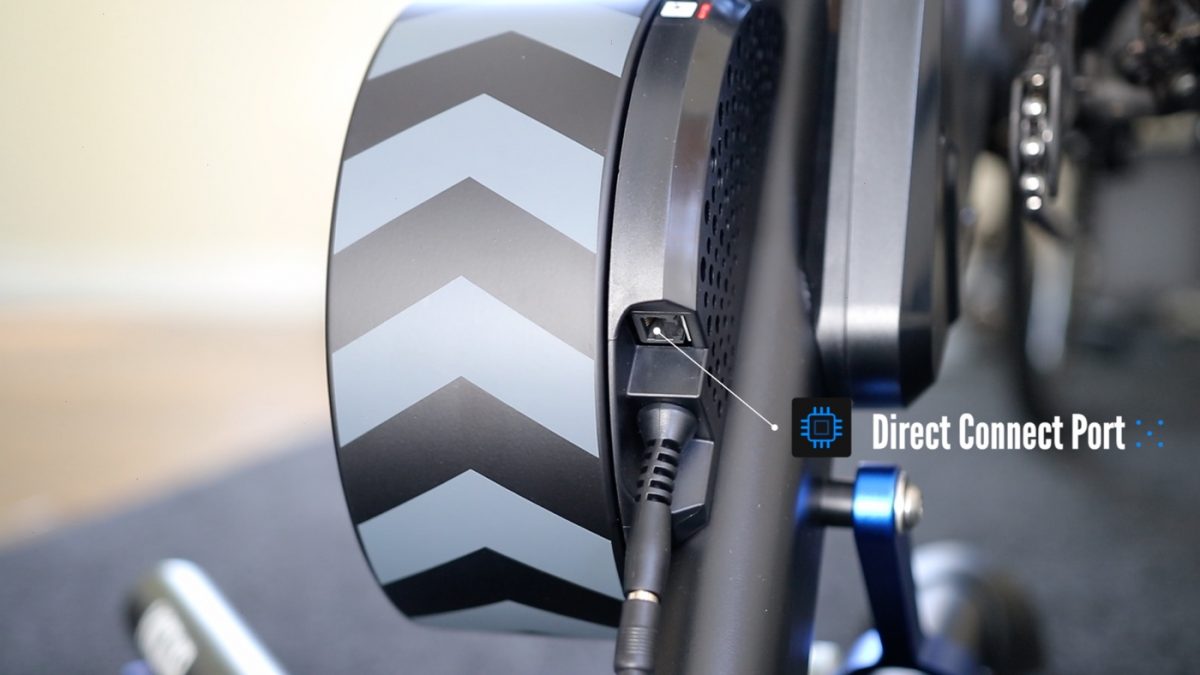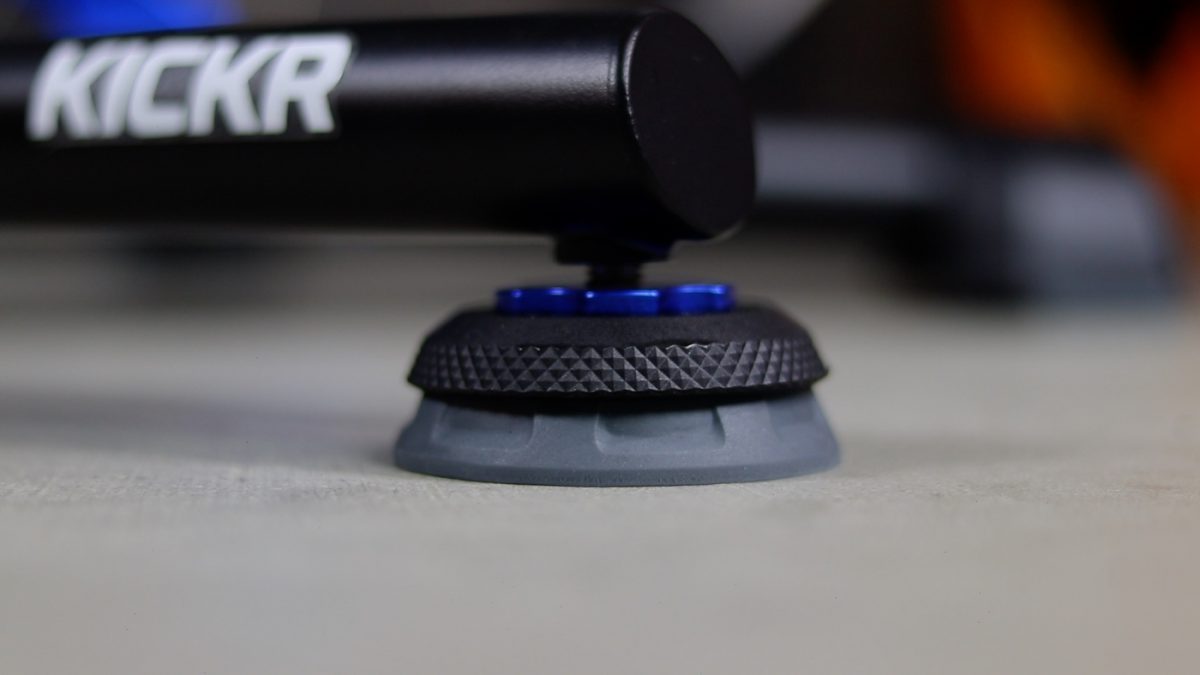PROS
- Accurate power & cadence measurement
- Doesn’t require calibration
- Three Bluetooth channels
- Power matching feature
- Direct Connect option
CONS
- Direct Connect POD is expensive
- Direct Connect option is still not available in Zwift
Wahoo Fitness announced the KICKR 2020 or KICKR 5 last August with a few minor updates. Even though the KICKR 5 has been mostly out of stock due to pandemic and high demand for indoor training, Wahoo was kind enough to send me this trainer for this review.
The new KICKR smart traienr features power accuracy within +/-1%. This is an improvement from the +/-2% the previous generation had and similar to the KICKR Bike. However, unlike the previous generation where you have to manually calibrate the trainer to ensure accuracy, the KICKR 5 has a proprietary auto-calibration process, so you never have to calibrate it or worry about power accuracy. Just get on and ride.
Here is a list of what’s new with the KICKR 5:
- Auto-calibration.
- Improved +/- 1% power accuracy
- KICKR AXIS cushioned feet
- Direct Connect option.
Other than that, everything else remained the same. The same 16 lbs flywheel, same 2,200 maximum watts, and same 20% maximum gradient.
While I covered everything in the video above, I will discuss the power accuracy and my final thoughts on Wahoo KICKR. However, if you want to know more about the KICKR 2020 and even listen to how loud or quiet the trainer is, then I encourage you to watch my video review.
Buy Wahoo KICKR from Wahoo Fitness.
KEY SPECS
- PRICE: $1,200
- DESIGN: The KICKR is built with a steel frame. It comes with foldable legs, and adjustable height, a handle, and cushioned feet.
- MAXIMUM SLOPE: The KICKR 5 can simulate gradients up to 20%.
- ACCURACY: +/-1%.
- WHEEL SIZE: 24″, 650c, 700c, 26″, 27.5″, 29″.
- AXLE: 130 and 135mm quick release, 12x142mm, and 12x148mm.
- CASSETTE COMPATIBILITY: 11 Speed with 11-28 ratio included. Compatible with 8, 9 & 10 Speed.
- CONNECTIONS: Smart Bluetooth x3, ANT+ FE-C compatible.
- FLYWHEEL: 16 lbs / 7.3 kg flywheel.
- CALIBRATION REQUIRED: NO
- METRICS: Transmits power, speed, and cadence.
DIRECT CONNECT OPTION

The new Wahoo KICKR comes with a built-in Direct Connect option. This is a built-in port for wired connectivity that should enable you to connect to your WiFi network. This feature is there to help eliminate the frustration many cyclists who experience ANT+ or Bluetooth dropouts.
However, this option isn’t ready yet. There is an additional accessory that you need to buy for $80 to enable the Direct Connect option.
Five months after the initial release of the KICKR 5, the Direct Connect was released and you can get yours for $99.99. This tiny little dongle connects to your Wahoo KICKR and hardwires the KICKR directly to your home network by connecting it to your WiFi network or PC’s ethernet port.

You can read more about the Direct Connect option and how it works in my post here.
The Direct Connect is compatible with Wahoo’s SUF Training System, TrainerRoad, FullGaz, and RGT Cycling. Other platforms, mainly Zwift are expected to become compatible in the coming months. Compatibility with all third-party apps depends on developers so it’s out of Wahoo’s hand at this point.
AXIS FEET

Wahoo added cushioned axis feet to the KICKR 5. These cushioned feet, made from rubber-type material – allow up to 5 degrees of side to side tilting. The AXIS feet come in three stiffness options – easy, medium, and hard.

To change the axis feet, all you need to do is replace the top cap. These top caps are weight specific and you need to select the appropriate top cap for your weight. Wahoo has a little warning or a disclaimer to use the appropriate top cap. By default, the Kickr comes with the medium one installed.

Now, if you are familiar with previous Kickrs, then you know how rigid this trainer can be and the only movement you feel is the natural flexing from your bike particularly carbon bikes. The idea behind these feet is to give you a more natural movement on the bike by minimizing pressure touchpoints resulting in less fatigue and the ability to stay on the bike for longer.
Now these feet aren’t going to provide you with a noticeable rocking motion. And just because the rocking motion isn’t noticeable, it doesn’t mean it’s less comfortable or more comfortable than previous Kickrs. If anything, it didn’t feel that much different to me. However, there is a slight and noticeable side to side movement.

Does it make it feel more comfortable, I am not totally sold on that. Like I said in other videos, for a comfortable ride, you want your bike to move under you and with you and not forced in a static motion one way or the other. So I won’t go and spend my money on a new KICKR just for this feature if comfort has been an issue for you.
The good news is, these feet are compatible with previous kickrs – except the Kickr Core and KICKR Snap – and you can get your own axis feet for about $80
POWER ACCURACY
- The KICKR measures power accurately based on my comparisons against two different power meters – Assioma Duo pedals and Power2Max crank-based power meter.
- In ERG mode, it responded to changes in intervals within 3-4 seconds.
- When using big gear (53-12), the KICKR was able to hit very low watts around 100 watts in ERG mode which can be an issue for most trainers.

Even though the spin down calibration is still available in the Wahoo Fitness app, the KICKR 5 doesn’t require calibration. It will automatically perform a calibration every few minutes. This is important for a few reasons. One is you don’t have to worry about running it yourself and interrupting your training session. You don’t have to worry if the trainer is accurate because it’s been a few months since you last ran the calibration. Also, it will continuously override any altered calibration value that you might have unintentionally or intentionally altered during the spin-down procedure.
Here is a ride I did on Zwift in Sim mode. As you see in the graph below, all looks good. Assioma was measuring a little higher, followed by my crank based power meter, and the KICKR was measuring the lowest. This is expected since the KICKR measures power from the hub rather than the pedals or cranks. Overall, the KICKR Normalized Power for the ride was about 5 watts lower than the Assioma pedals and 3 watts lower than my crank based power meter which is as expected.

Here is a little sprint I did towards the end of the ride. The KICKR and Assioma were moving in sync throughout. However, my Power2Max crank-based was a little lower for some reason but that’s a Power2Max issue.

ERG MODE AND POWER DISTRIBUTION
Switching over to ERG mode, the KICKR worked well to keep me at my target watts regardless of gear. Using the same 3x10min workout that I normally use to test trainers responsiveness in ERG mode, the KICKR responded well regardless of gear selection. But let’s dig into the details.

The frist section of the workout is 3x20seconds on and off. This is to see how quickly the trainer changes resistance. Overall, the KICKR made adjustments fairly quickly and I was up from 100 to 300+ watts within 3-4 seconds. These intervals were all done using the small chainring.

Moving on to the longer sets. This is where I like to see how trainers maintain ERG mode with different gearing combinations and if there are any changes in power measurements.

The KICKR behaves best in smaller gears which is typical for all trainers. However, it did fall short hitting the target watts in TrainerRoad when in the small ring. But I am talking about 1 watt here. As you see in the table below, my target for the 10-minutes was 234. When using the small ring, even though it kept me within +/-10 watts of my target, it came in short by 1 watt.

When going to a bigger gear, it was spot on in TrainerRoad. I don’t know why but that was the case with almost all my rides in TrainerRoad when using smaller gear. I personally don’t like riding trainers in the small chainring, it doesn’t feel natural to me and I only use it when testing.
In the second 10 minute interval, I switched to the big chainring and a middle cog. Overall, the KICKR behaved as expected. Here is the graph from the second 10-minute interval.

Going to a much bigger gear, This is where you probably shouldn’t be riding anyway. But that’s what I do here, I try to find the limitations on these trainers. The KICKR continued to respond well. A little more variation in power which is also expected when riding in a gear like this. In my 53/13 gear, I spent about 44.6% or 4:22min within +/-10 watts of my target watt. About 2:44 minutes was spent under 224 watts and 2:14 minutes was spent over 244 watts.

And here is the power distribution table for the three 10minutes intervals.

CADENCE
The KICKR measures and broadcasts cadence so there is no need to purchase a separate cadence sensor. The KICKR measures cadence accurately and I didn’t see any issues when comparing it to my Assioma Pedals cadence measurement. Some drops or spikes throughout my rides but we are talking about once or twice during a ride.

FINAL THOUGHTS
The KICKR 2020 direct drive trainer has been the leading smart trainer in this market. Wahoo has been slowly making improvements making it quieter, better, and more accurate. Fundematality there isn’t much difference between this year’s KICKR vs the last KICKR. Still, the same premium Wahoo Kickr that you are familiar with. Auto calibration is a great addition, possibly a tiny bit more comfortable with axis feet, and we will see what happens with the built-in port.
WHERE TO BUY
The KICKR 2020 is available for $1,200 and can be purchased directly from Wahoo Fitness, REI, or CleverTraining.








